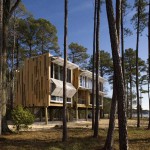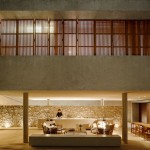Interview with Bertrand Benoit
I present to you this interview with HOVER judge Bertrand Benoit, Grand Prize Winner of the previous GH House challenge and also 2010 Architectural Awards Winner in Best Architectural Image with the same GH House entry. Starting as a photographer and moving into 3d visualization for the limitless option, he is someone to follow and learn from.
Please tell us a little bit about yourself and how you initially became interested in Architectural Visualization? Do you have any formal training in this field?
Unlike many colleagues in the field, I wasnt trained as an architect but came to Visualization via photography about four years ago. I was attracted to CG as a means to push the boundaries I was encountering in architectural photography. The ability to create photorealistic renders of virtual scenes on off-the-shelf hardware was what initially fired my interest.
Interior vizualisation animation from Bertrand Benoit on Vimeo.
Do you have any background or interest in traditional art and if so does it help you to make your digital 3d art better?
I do have a relatively strong and much older – drawing background, but I think my comparatively recent photography background is much more crucial to making my 3d work better. It helps you to know how far you can push some effects such as a shallow DOF without making an image photographically implausible. I think its no coincidence that many of the best Archviz artists, people like Peter Guthrie, are also excellent photographers in their own right.
What is your favorite project / render that you have done?
Im not sure I have a favorite project. Im quite critical of my own work. I find it hard to look at my images, especially older ones, without finding anything I would do differently and, hopefully, better if I were returning to them now. I guess thats because Im still learning so much with each new project. Which is why, very often, my favorite project happens to be my latest one.
On what types of projects you like to work best?
I like to work on promotion and marketing material since these tend to stress the artistic (rather than the informational) qualities of an image most and give the artist the biggest amount of freedom. If I were to be completely honest, though, I would say I much prefer to work on personal projects, where freedom is absolute. I almost never publish images of paid-for projects even when Im allowed to.
What’s the archviz field like in your local area?
I couldnt really say as I almost never worked for local architecture firms.
What do you like to do when you are not working?
Above all I like to spend time, of which I have far too little, with my kids and wife. If theres time, mainly photography and personal 3d projects, including non-Archviz stuff.
What is your software of choice? Do you use more the one modeling / rendering application in your workflow?
I use mainly 3ds Max, VRay and ZBrush, plus a zillion 3ds Max plugins. I still use Blender quite extensively, although mainly for compositing purposes and no longer so much for rendering and modeling.
Im very intrigued by Octane, which I also own, but Ive been unable to use it lately because it requires the most recent NVidia drivers to work. Unfortunately, most of the drivers written for my GTX 285 in the past year slow 3ds Max down to a crawl. So for the moment, unfortunately, Im having to choose between Octane and Max.
Once Octane is made to run on non-NVidia cards, I will consider changing card makes and return to Octane as I think it is a very powerful piece of software.
You previously used Blender + VRay for Blender combination and turned out great images. Why did you make the move to 3ds Max?
There are many different reasons. One of them was frustration at the reluctance of commercial software firms to make their tools compatible with Blender. Blender is an amazing and extraordinarily powerful application. But its somewhat isolated in its open-source corner. Another, somewhat related, reason was VRay. Id fallen in love with the renderer when using it in Blender. The work done single-handedly by Andrey Izrantsev, a very gifted coder, to make VRay available to the Blender community was astonishing. But I had reached such a stage of infatuation with VRay that I desperately wanted to use all the features that were only at the time available in the 3ds Max version.
Can you tell us about other tools you can’t do without these days?
These are pretty much all the tools Im using, but I should give VRay a special mention here as I think its the only tool I could say Im forever married with. Not only does it have everything I could ever need from a renderer, but ChaosGroups customer policy is among the most enlightened in the business. Its not the only reason but its one of the main reasons why Im sticking to 3ds Max.
Photoreal or NPR – where do you stand in this debate?
Definitely photoreal, although I concede that this is very much a matter of taste and therefore highly subjective. Im very attracted to some of the more abstract or stylized work but I dont think I could produce any.
Are you a post work or pure render type of artist? (Granted, post work is always needed, but how much remains for you to do in post)
Im a strong believer in doing as much as possible in 3D. I would never paint additional texture layers in 2d on finished renders, for instance. I do this in 3ds Max when needed by applying texture layers after texture layers using different UV sets. I also would rather model my surroundings and entourage than compositing them. This is not because I think the outcome looks better that way (it frequently doesnt), but I want to have maximum freedom in placing my camera once a scene is fully modeled and shaded.
I also like to know that I could animate my scene if I wanted to and not be restricted to stills. Of course, post-work is always a must when it comes to color correction and some lens effects. You can improve a good render enormously with sensible post-work, but I think you can never rescue a mediocre render.
What other artists inspire you?
All the usual suspects: Peter Guthrie whom Ive mentioned, Alex Roman, Viktor Fretyan, the entire Berlin team at Pure and all the others I forget. I also keep a close eye on non-Archviz CG stuff and am a great fan of people like Stefan Morrell.
What do you find most challenging in your daily work?
Implementing artistic concepts I dont believe in. Its hard to persuade viewers when youre not persuaded yourself.
How do you keep up to date will all the frequent software updates and plugin additions? Do you even bother yourself with that?
I try to keep up to date. But it can become quite a distraction from actually doing art. On this note, I would say it was a very wise idea of Autodesk to keep its SDK stable between Max 2010 and 2011. Migrating used to be a nightmare when one had to wait for all plugins to be updated.
What would you suggest to someone wanting to become part of this industry? What are the essential skills to focus on when one starts?
To be honest, the industry has become so global and so competitive, and the barriers to entry so low, that I dont know if I would recommend anyone to become a visualizer. One thing I would say is that strong artistic skills are a prerequisite but they are nothing without a strong business sense and an ability to understand clients needs.
Beyond that, I would recommend beginners keep a close eye on competitors work and try to learn as much as they can from them both technically and artistically while vying to make their work stand out from the crowd and trying to get noticed. Having said that, I think one thing that is hugely important is to make sure you dont restrict yourself to other peoples CG as your sole source of inspiration. Look at photographs, look around you and try to think of how you would translate what you see into CG. This is probably the best way to push your limits and improve your work.
What do you love about doing what you do? What is your motivation to keep going?
What I love is the absolute freedom CG gives you to break the laws of physics. CG is the most empowering and liberating artistic tool I can think of.
Do you have any interesting projects going on at the moment?
I have a million projects but sadly far too little time right now to make them come to fruition.
You do a lot of personal projects. What is the motivation behind that? And how do you find the time?
The sole motivation is the superior satisfaction one gets from doing personal projects and the fact that they really allow you to push yourself. Just to illustrate the point: In a commercial environment, one would not model every single piece of furniture or every plant. It would not make business sense. But you can do that in a personal project and producing your own assets and creating something that is very much the product of your own work is intensely satisfying.
Finding the time is the biggest challenge of all. Sometimes these projects come to the detriment of paid work and, more often, of sleep. I wish I didnt have to sleep.























Glad to know that I’m not the only one who doesnt have an architectural background, Bertrand is an inspirational artist.
Excelent work.
Bertrand mentioned about Octane renderer, and I was researching about it for couple days, it looks like a very promising GPU based renderer. And I am thinking about purchasing a QuadroFX1800 which has CUDA enabled drive in order to use the power of Octane. I heard that GPU rendering can provide you with at least 48 cores or something like that instead of just 8 cores from i7. I think it could be a very interesting topic to discuss on your blog, Ronen.
Thanks,
Art
I think so too, and started to look into it too 🙂
I wouldn’t recommend getting a Quadro for GPU rendering though. The GeForce cards have much more CUDA cores and that is what counts!
the Quadro FX 1800 has 64 and the GTX 480 has, well… 480!!!
Talking with the good people at refractive software they highly recommend the GTX 480 and also suggest getting a secondary card just for on screen operations. You all need to remember that when the GPU is rendering the screen performance drops to none if you do it all on one card.
Gaming cards seems the best value for money currently.
My compliments Bertrand… Your work is absolutely excellent!
For me its a? honor being a judge along your side and I’m glad to know more about you.
cheers,
kizo
Good interview. Truly a talented artist.
Sorry, but even as a beginner I didn’t gain much from reading that interview and he seems kind of grumpy about the arch-vis industry. Though theres no denying the quality of his work!
@artmak I have used a FX1800 for Octane and i’ll tell yo it’s not really fast. It’s all about the CUDA cores, the FX1800 has got 64 cores, enough to use CUDA but not much really… I’ve bought now a GTX470 it has 448 CUDA cores and it blasts with Octane!! About the viewport i don’t see the difference with the Quadro and the best of all: it’s much cheaper than the FX1800 and if you like games…you can play them full-quality. I’m not going back to Quadro yet…
PS: RAM is also double as much…very important when rendering on the GPU. XD
Mateuet – thanks for the info, I was already looking about investing in GTX480 or getting 2 GTX460 for about same price.
But I am glad you have success working with Octane, thats what I wanted to hear.
I added a comment to your previous message here… Mateuet is spot on 🙂
For the same money getting the 2×460 might be better since you can split them for screen and render when you want to keep working.
Mind you, I get very good performance on screen with some old GeForce 8800 cards so I’m using them for screen and will add GTX 480’s to take advantage of GPU render…
This is all new for me here so i’ll have to learn it as I go and i’ll keep you posted about it.
Ronen – thanks for the suggestion, I keep reading octane forums and I see that a lot of people do use 2 graphic cards, one for screen and one for rendering.
I am still a bit confused about splitting those cards between screen and render, it sounds complicated, and is there a way to combine them later if I want to render some big scene and I need a lot of memory or is it stuck that way forever if I put one for screen and one for GPU rendering?
I like your suggestion about GeForce 8800 cards, they are relatively cheaper than the new GTX series, so getting one for screen can save a ton of money and then getting the expensive one for rendering makes sense.
I also, saw another software called LuxRender, it works with ATI graphic cards and it is free, have anybody tried it?
Not sure about adding all GPU cards up for the render process. Might be that you have to have them in SLI mode to do that and in that case you’ll probably need Identical twin or triplet cards 🙂
You can also consider a Tesla or a GPU-Xpander from Cubix for the flexabilty… though not tested by me yet – http://www.cubix.com/products/gpu-xpander
One more thing to keep in mind is power consumption by all this monster cards! 1KW PSU is a must even 1.1 in some cases 🙂
I know now that SLI is not needed, and you can mix brands and type of cards.
The big problem is on-board memory… scene must be fully loaded prior to render. with a 1.5GB GTX 480 that is a problem (and you can’t add memory among cards)
The newest 6GB memory cards are more expensive then a perfectly fast top of the line dual six core xeon’s with 12-24GB of RAM
They might render faster but the GPU render engine version are not feature complete yet as far as I’ve seen.
I’ll keep exploring this field though.